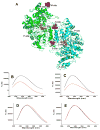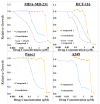Identification of Non-nucleoside Human Ribonucleotide Reductase Modulators
- PMID: 26488902
- PMCID: PMC4751996
- DOI: 10.1021/acs.jmedchem.5b00929
Identification of Non-nucleoside Human Ribonucleotide Reductase Modulators
Abstract
Ribonucleotide reductase (RR) catalyzes the rate-limiting step of dNTP synthesis and is an established cancer target. Drugs targeting RR are mainly nucleoside in nature. In this study, we sought to identify non-nucleoside small-molecule inhibitors of RR. Using virtual screening, binding affinity, inhibition, and cell toxicity, we have discovered a class of small molecules that alter the equilibrium of inactive hexamers of RR, leading to its inhibition. Several unique chemical categories, including a phthalimide derivative, show micromolar IC50s and KDs while demonstrating cytotoxicity. A crystal structure of an active phthalimide binding at the targeted interface supports the noncompetitive mode of inhibition determined by kinetic studies. Furthermore, the phthalimide shifts the equilibrium from dimer to hexamer. Together, these data identify several novel non-nucleoside inhibitors of human RR which act by stabilizing the inactive form of the enzyme.
Conflict of interest statement
The authors declare no competing financial interest.
Figures





Similar articles
-
Structure-guided design of anti-cancer ribonucleotide reductase inhibitors.J Enzyme Inhib Med Chem. 2019 Dec;34(1):438-450. doi: 10.1080/14756366.2018.1545226. J Enzyme Inhib Med Chem. 2019. PMID: 30734609 Free PMC article.
-
Potent competitive inhibition of human ribonucleotide reductase by a nonnucleoside small molecule.Proc Natl Acad Sci U S A. 2017 Aug 1;114(31):8241-8246. doi: 10.1073/pnas.1620220114. Epub 2017 Jul 17. Proc Natl Acad Sci U S A. 2017. PMID: 28716944 Free PMC article.
-
Modeling and Proposed Molecular Mechanism of Hydroxyurea Through Docking and Molecular Dynamic Simulation to Curtail the Action of Ribonucleotide Reductase.Recent Pat Anticancer Drug Discov. 2016;11(4):461-468. doi: 10.2174/1574892811666160926143534. Recent Pat Anticancer Drug Discov. 2016. PMID: 27670694
-
Ribonucleotide reductase inhibitors and future drug design.Curr Cancer Drug Targets. 2006 Aug;6(5):409-31. doi: 10.2174/156800906777723949. Curr Cancer Drug Targets. 2006. PMID: 16918309 Review.
-
Syntheses and antitumor activities of potent inhibitors of ribonucleotide reductase: 3-amino-4-methylpyridine-2-carboxaldehyde-thiosemicarba-zone (3-AMP), 3-amino-pyridine-2-carboxaldehyde-thiosemicarbazone (3-AP) and its water-soluble prodrugs.Curr Med Chem. 2001 Feb;8(2):121-33. doi: 10.2174/0929867013373741. Curr Med Chem. 2001. PMID: 11172670 Review.
Cited by
-
Structure-guided design of anti-cancer ribonucleotide reductase inhibitors.J Enzyme Inhib Med Chem. 2019 Dec;34(1):438-450. doi: 10.1080/14756366.2018.1545226. J Enzyme Inhib Med Chem. 2019. PMID: 30734609 Free PMC article.
-
Pterostilbene inhibits hepatocellular carcinoma proliferation and HBV replication by targeting ribonucleotide reductase M2 protein.Am J Cancer Res. 2021 Jun 15;11(6):2975-2989. eCollection 2021. Am J Cancer Res. 2021. PMID: 34249439 Free PMC article.
-
Potent competitive inhibition of human ribonucleotide reductase by a nonnucleoside small molecule.Proc Natl Acad Sci U S A. 2017 Aug 1;114(31):8241-8246. doi: 10.1073/pnas.1620220114. Epub 2017 Jul 17. Proc Natl Acad Sci U S A. 2017. PMID: 28716944 Free PMC article.
-
TAS1553, a small molecule subunit interaction inhibitor of ribonucleotide reductase, exhibits antitumor activity by causing DNA replication stress.Commun Biol. 2022 Jun 9;5(1):571. doi: 10.1038/s42003-022-03516-4. Commun Biol. 2022. PMID: 35681099 Free PMC article.
-
Definition of fatty acid transport protein-2 (FATP2) structure facilitates identification of small molecule inhibitors for the treatment of diabetic complications.Int J Biol Macromol. 2023 Jul 31;244:125328. doi: 10.1016/j.ijbiomac.2023.125328. Epub 2023 Jun 10. Int J Biol Macromol. 2023. PMID: 37307967 Free PMC article.
References
-
- Jordheim LP, Seve P, Tredan O, Dumontet C. The ribonucleotide reductase large subunit (RRM1) as a predictive factor in patients with cancer. Lancet Oncol. 2011;12:693–702. - PubMed
-
- Jordheim LP, Guittet O, Lepoivre M, Galmarini CM, Dumontet C. Increased expression of the large subunit of ribonucleotide reductase is involved in resistance to gemcitabine in human mammary adenocarcinoma cells. Mol Cancer Ther. 2005;4:1268–1276. - PubMed
-
- Shao J, Zhou B, Chu B, Yen Y. Ribonucleotide reductase inhibitors and future drug design. Curr Cancer Drug Targets. 2006;6:409–431. - PubMed
-
- Huang P, Chubb S, Plunkett W. Termination of DNA synthesis by 9-beta-D-arabinofuranosyl-2-fluoroadenine. A mechanism for cytotoxicity. J Biol Chem. 1990;265:16617–16625. - PubMed
Publication types
MeSH terms
Substances
Associated data
- Actions
Grants and funding
LinkOut - more resources
Full Text Sources
Other Literature Sources

